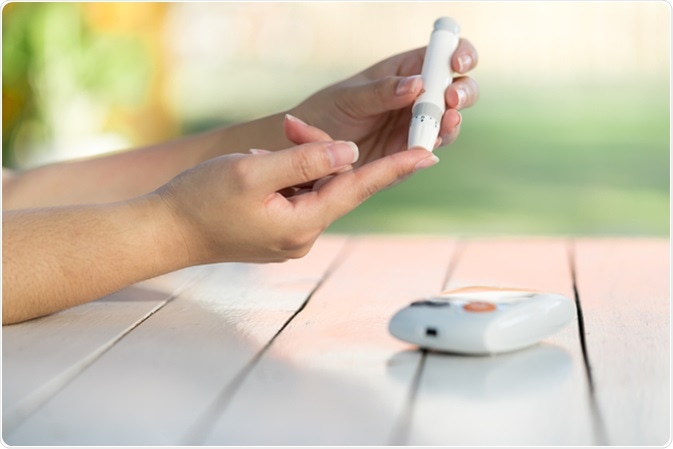Blood glucose control is required to be performed frequently and accurately, as well as safely, in many clinical situations. This helps diabetics to monitor their glucose levels without having to visit the doctor’s office or hospital, and thus makes stabilization of blood sugar achievable on a larger scale.
In many cases, it is preferable for the testing to be carried out at home, because it is less expensive, less invasive, and safer.
The sides of the finger pads are the most commonly used sites for home or near-patient (point-of-care) testing. This site is ideal, because the center of the finger pad contains an abundant nerve supply, which could make the needlestick more painful.

Checking blood sugar level by Glucose meter. Image Credit: Fahkamram / Shutterstock
Procedure
The best practice for finger sticking during blood glucose testing is as follows:
- Obtain consent
- Ensure that the patient is seated and explain the procedure clearly
- Always use gloves if you are going to lance someone else
- Make sure the hands are washed with soap and water and allowed to dry, or apply an alcohol-based sanitizer and leave it on for 30 seconds before lancing the finger. Water may lead to dilution of the blood, or the chemicals in the testing solution may solubilize too early, making the result invalid.
- In case the fingers are dirty or covered with sugar-containing material, and time is not available to allow alcohol or water to dry, the finger is pricked and the first drop of blood wiped away using clean gauze or tissue. There is no significant difference in the observed blood glucose whether the first or second drop is used for measurement. However, the finger should not be squeezed, because this may dilute the blood with fluid pushed out from the surrounding extracellular space.
- A disposable single-use lancet or needle should be used each time and the prick should be against the fingerprint lines, on the palmar aspect of the fingertip, to one or the other side of the center. This not only helps to avoid the nerves, but the bone as well, which could be damaged in very thin or small patients.
- The middle or ring finger is preferred as having the greatest depth of tissue beneath the skin and hence offering the least chances of injury.
- The thumb or index finger may be more likely to be calloused or scarred, as well as being much more sensitive, making the procedure more painful.
- If the patient had a prior mastectomy, it is preferable if she uses the fingers of the hand that is on the contralateral side of the breast that was removed.
- Repeated punctures should not be made on the same site to avoid pain and dilution of the blood with extracellular fluid.
- The fingers into which an intravenous infusion is being administered should not be used as the results are likely to be erroneous.
- After drawing blood into the glucose testing strip, the site is pressed gently with clean gauze or tissue.
- Read the device and explain the reading if required.
- Dispose of all equipment in line with safety policies.
- Recalibration of the device should be done weekly.
Other sites for capillary blood sampling for blood glucose measurement include the heel (especially in neonates) and the earlobe. This method of blood testing needs only a minute amount of blood and is much faster as well as easier than venepuncture, for which reasons it is now very popular. This is even more important in children because of the minimal quantities of blood required for testing, which avoids iatrogenic anemia.
Incorrect performance of finger pad sticking can result in inaccurate measurement, as well as pain or damage to the finger.
How to test your blood glucose (sugar) levels
Heel Puncture
Heel puncture is used to sample capillary blood in newborns if venepuncture is ruled out for any reason. It is painful and therefore the infant should be with the mother whenever possible, being nursed or rocked, swaddled or given a pacifier to suck, or even fed with sweetened water. It is noteworthy that local anesthesia or acetaminophen do not relieve the pain of a heel prick while it is being performed.
Newborn Care Series: Taking a Heel Blood Sample
References
Further Reading